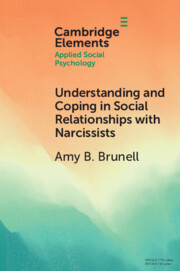Refine search
Actions for selected content:
38 results
6 - A Contemporary Integrative Interpersonal Theory Formulation of Self and Social Pathology
- from Part II - Contemporary Approaches to Traditional Conceptual Perspectives
-
-
- Book:
- Conceptualizing Personality Disorder
- Published online:
- 25 June 2025
- Print publication:
- 10 July 2025, pp 108-129
-
- Chapter
- Export citation
21 - Interaffectivity Disturbances in Narcissistic Personality Disorder
- from Part V - Perspectives on Borderline and Narcissistic Personality
-
-
- Book:
- Conceptualizing Personality Disorder
- Published online:
- 25 June 2025
- Print publication:
- 10 July 2025, pp 373-385
-
- Chapter
- Export citation
20 - Empathy Deficits in the Development and Maintenance of Narcissistic Personality Disorder
- from Part V - Perspectives on Borderline and Narcissistic Personality
-
-
- Book:
- Conceptualizing Personality Disorder
- Published online:
- 25 June 2025
- Print publication:
- 10 July 2025, pp 352-372
-
- Chapter
- Export citation
Chapter 5 - Groups of Prejudice and Intolerance
- from Section 1 - Typology
-
-
- Book:
- A Clinical and Forensic Guide to Cults and Persuasive Leadership
- Published online:
- 19 June 2025
- Print publication:
- 03 July 2025, pp 87-117
-
- Chapter
- Export citation
Better than you or who I used to be: Social comparison, but not temporal comparison, maintains narcissism in adolescence
-
- Journal:
- Development and Psychopathology , First View
- Published online by Cambridge University Press:
- 26 May 2025, pp. 1-15
-
- Article
-
- You have access
- Open access
- HTML
- Export citation

Understanding and Coping in Social Relationships with Narcissists
-
- Published online:
- 04 December 2024
- Print publication:
- 16 January 2025
-
- Element
- Export citation
Chapter 4 - Drives
-
- Book:
- Freud's Thinking
- Published online:
- 21 September 2023
- Print publication:
- 05 October 2023, pp 90-123
-
- Chapter
- Export citation
Chapter 2 - The Supporting Theory of Psychodynamic Psychotherapy
- from Part 1: - An Overview of the Model
-
- Book:
- Cambridge Guide to Psychodynamic Psychotherapy
- Published online:
- 25 August 2023
- Print publication:
- 10 August 2023, pp 18-50
-
- Chapter
- Export citation
Chapter 6 - Narcissistic Personality Disorder
- from Part III - Application and Adaptations for Mental Health Presentations
-
- Book:
- Cambridge Guide to Mentalization-Based Treatment (MBT)
- Published online:
- 18 May 2023
- Print publication:
- 01 June 2023, pp 155-173
-
- Chapter
- Export citation
Overcoming Narcissism
-
- Article
-
- You have access
- Open access
- HTML
- Export citation
Narcissism and the perception of failure – evidence from the error-related negativity and the error positivity
-
- Journal:
- Personality Neuroscience / Volume 6 / 2023
- Published online by Cambridge University Press:
- 09 February 2023, e2
-
- Article
-
- You have access
- Open access
- HTML
- Export citation
Why and When Narcissistic Employees Are More Creative in the Workplace? A Social Cognitive Perspective
-
- Journal:
- Management and Organization Review / Volume 19 / Issue 3 / June 2023
- Published online by Cambridge University Press:
- 06 January 2023, pp. 567-593
-
- Article
- Export citation
Chapter 23 - Theorizing the Other
- from Part III - Bodies
-
-
- Book:
- David Foster Wallace in Context
- Published online:
- 18 November 2022
- Print publication:
- 01 December 2022, pp 246-256
-
- Chapter
- Export citation
Narcissistic Sociopathy in Global Autocratic Leaders: Arrested Development, Obsessive Demand for Power, and the Emergence of Unlawful Hybrid Wars
-
- Journal:
- Disaster Medicine and Public Health Preparedness / Volume 17 / 2023
- Published online by Cambridge University Press:
- 14 October 2022, e263
-
- Article
-
- You have access
- Open access
- HTML
- Export citation
Considering Envy and Rivalry within the nomological network of pathological narcissism: an empirical study
-
- Journal:
- European Psychiatry / Volume 65 / Issue S1 / June 2022
- Published online by Cambridge University Press:
- 01 September 2022, p. S667
-
- Article
-
- You have access
- Open access
- Export citation
Narcissism as a protective factor against the risk of self-harming behaviors without suicidal intention in Borderline Personality Disorder. Preliminary results
-
- Journal:
- European Psychiatry / Volume 65 / Issue S1 / June 2022
- Published online by Cambridge University Press:
- 01 September 2022, p. S664
-
- Article
-
- You have access
- Open access
- Export citation
11 - Body Image, Narcissisms, and Depression
- from Part IV - Which Possible Horizons? Some Final Considerations
-
- Book:
- Body Image and Eating Disorders
- Published online:
- 26 May 2022
- Print publication:
- 09 June 2022, pp 125-143
-
- Chapter
- Export citation
6 - Absence of the Other
- from Part III - Hearing Absence
-
- Book:
- Music, Subjectivity, and Schumann
- Published online:
- 07 April 2022
- Print publication:
- 07 April 2022, pp 191-229
-
- Chapter
- Export citation
Chapter 6 - Emotional Injury: Causes and Consequences
-
- Book:
- Dear John
- Published online:
- 04 January 2022
- Print publication:
- 06 January 2022, pp 179-210
-
- Chapter
- Export citation
3 - Rivalry and the Favorite Child in Jane Austen’s Pride and Prejudice and Persuasion
- from Part I - In History
-
-
- Book:
- The Cambridge Companion to Literature and Psychoanalysis
- Published online:
- 16 December 2021
- Print publication:
- 16 December 2021, pp 54-72
-
- Chapter
- Export citation
